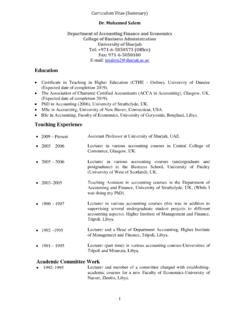Transcription of Executive Summary - OECD
1 Executive Summary 9 THE OECD INNOVATION STRATEGY: GETTING A HEAD START ON TOMORROW OECD 2010 Executive Summary Innovation drives growth and helps address social challenges The past two years have seen reduced potential output growth, increased unemploy-ment and soaring public debt. To recover and move towards a more sustainable growth path, new sources of growth are urgently needed. At the same time, some traditional sources of growth are declining in importance. Many countries have stagnating or declining populations, and this reduces the role of labour input in long-term economic growth. Moreover, investments in physical capital face diminishing returns and may be insufficient to strengthen long-term growth, especially in advanced economies.
2 Innovation, which involves the introduction of a new or significantly improved product, process or method, will increasingly be needed to drive growth and employment and improve living standards. This is true as well for emerging economies that look to innovation as a way to enhance competitiveness, diversify their economy and move towards more high value added activities. Innovation is already an important driver of growth in some countries. Firms in several OECD countries now invest as much in intangible assets, such as research and development (R&D), software, databases and skills, as in physical capital, such as equipment or structures. Much multifactor productivity (MFP) growth is linked to innovation and improvements in efficiency. Preliminary estimates indicate that in Austria, Finland, Sweden, the United Kingdom and the United States, investment in intangible assets and MFP growth together accounted for between two-thirds and three-quarters of labour productivity growth between 1995 and 2006, thereby making innovation the main driver of growth.
3 Differences in MFP also account for much of the gap between advanced and emerging countries. This suggests that innovation is also a key source of future growth for emerging economies. This economic challenge coincides with increasing political pressure to meet various social challenges, such as climate change, health, food security, or access to clean water, many of which are global in nature or require global action. These challenges cannot be dealt with by any single country and require better co-ordination of effort by countries and through both supply- and demand-side interventions. Innovation is crucial for solving such problems in an affordable and timely manner. In the absence of innovation, addressing climate change, for example, will be considerably more costly.
4 Moreover, innovation-driven growth makes it easier for governments to make the necessary investments and undertake the policy interventions to address these challenges. 10 Executive Summary THE OECD INNOVATION STRATEGY: GETTING A HEAD START ON TOMORROW OECD 2010 Action on innovation must be a priority for emerging from the crisis The crisis has only served to underscore the need for innovation as a way to provide new solutions. While expenditure cuts are needed, governments must continue to invest in future sources of growth, such as education, infrastructure and research. Cutting back public investment in support of innovation may provide short-term fiscal relief, but will damage the foundations of long-term growth. Public investment in basic research, in particular, provides the seeds for future innovation, as it did in the past for the Internet and the Human Genome Project.
5 It will also be needed to foster the breakthrough technologies for dealing with climate change and other global challenges. At the same time, there is considerable scope to improve the efficiency of government spending and innovate in the delivery of public services. Reforms of education and training systems and public research institutions, for example, can help increase returns from public investment in innovation. Moreover, many policy actions that can help strengthen innovation do not require additional or significant public investment. Structural policy reforms of the framework conditions that support innovation, such as the removal of regulatory barriers to innovation and entrepreneurship, including administrative regulations, as well pro-growth tax reforms, can do much to strengthen innovation and growth.
6 In most countries, markets can also be strengthened to unleash demand for innovative products and services that meet social and global needs. Getting prices right, opening markets for competition and devising innovation-inducing standards and smart regula-tions are among the approaches that governments can use to unleash innovation in areas such as health and the environment. Better use of public procurement can also be effective, in particular when government is a large consumer. Well-designed demand-side policies are less expensive than direct support measures; they are also not directed at specific firms, but reward innovation and efficiency. Demand is closely linked to supply, however, and supply-side policies are necessary to create the conditions for business to innovate.
7 Policies need to reflect innovation as it occurs today If policies to promote innovation are to be effective, they need to reflect the ways in which innovation takes place today. To transform invention successfully into innovation requires a range of complementary activities, including organisational changes, firm-level training, testing, marketing and design. Science continues to be an essential ingredient of innovation, even though innovation now encompasses much more than R&D. Innovation also rarely occurs in isolation; it is a highly interactive and multidisciplinary process and increasingly involves collaboration by a growing and diverse network of stakeholders, institutions and users. Moreover, the emergence of new and important players has added to the complexity of the multifaceted international landscape of innovation.
8 Executive Summary 11 THE OECD INNOVATION STRATEGY: GETTING A HEAD START ON TOMORROW OECD 2010 These and other changes in the innovation process present a challenge to existing national policy frameworks. Policy will need to move beyond supply-side policies focused on R&D and specific technologies to a more systemic approach that takes account of the many factors and actors that influence innovation performance. The objective of policy should not be innovation as such, but the application of innovation to make life better for individuals and society at large. This is no easy task, especially as the scope for policies for innovation broadens. The objective of the OECD s Innovation Strategy is to support this process of policy development, recognising that one size does not fit all.
9 It is built around five priorities for government action, which together form a coherent and comprehensive approach to policies for innovation that can help underpin an innovation-led recovery and strengthen the role of innovation in the long run. People should be empowered to innovate Human capital is the essence of innovation. Empowering people to innovate relies on broad and relevant education as well as on the development of wide-ranging skills that complement formal education. Curricula and pedagogies need to be adapted to equip students with the capacity to learn and apply new skills throughout their lives. At the same time, education and skills development systems require reform to ensure they are efficient and meet the requirements of society today. Improving teacher quality is particularly important for enhancing outcomes; this might include better initial selection of teachers, ongoing evaluation to identify areas for improvement, and recognising and rewarding effective teaching.
10 Universities, colleges and vocational training centres are essential nodes in the innovation system, both producing and attracting the human capital needed for innovation. These institutions act as essential bridges between players businesses, governments and countries in broader and more open systems of innovation. The major policy challenge is to recognise the essential role of universities in the innovation enterprise rather view them, as is all too commonly the case, simply as providers of essential public goods. This requires a greater focus of policy makers on ensuring independence, competition, excellence, entrepreneurial spirit and flexibility in universities. Entrepreneurs are particularly important actors in innovation, as they help to turn ideas into commercial applications.

















